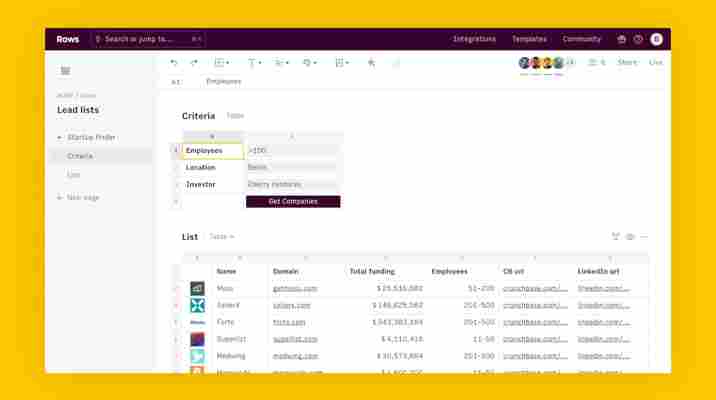Spreadsheet software company Rows has launched a new desktop application in beta, in an effort to undermine the dominance of Microsoft Excel and Google Sheets .
The company released the beta in stealth back in December, but has now gone public with native applications for both Windows and macOS, TechRadar Pro can reveal.
Until now, Rows has been available exclusively as a web app, which had placed a limit on performance. However, the company says the new desktop build will support complex and large-scale sheets as efficiently as the market leaders, as well as providing a foundation for functionalities only available with Rows.
Spreadsheets, but different
The central ethos behind the Rows project is that the spreadsheet software market is ripe for disruption. The duopoly of Microsoft and Google has led to a dearth of innovation, the company believes, leaving the door wide open for an ambitious challenger.
“Let’s face it. Spreadsheets suck,” said Humberto Ayres Pereira, Rows co-founder and CEO. “The business world still runs on them but they’re slowing us down. Rows is bringing the beloved spreadsheet into the modern working world.”
The company has not been shy about its ambitions to topple the incumbents. As part of a recent marketing campaign, Rows rented billboard space close to the Microsoft headquarters and erected a sign that read: “Dear Microsoft, your spreadsheet has been at it for 36 years. It’s time to retire.” And Google was given the same treatment.
To understand what distinguishes Rows from every other spreadsheet software, we spoke to Renan Araújo , who is heading up the development of the desktop app. Although Rows features all the familiar spreadsheet functionality - cells, rows, columns, functions, tables etc. - the service differs from Excel and Sheets in a few crucial ways, he told us.

Most significantly, Rows has focused closely on the ability to integrate third-party APIs into spreadsheets, with little to no coding expertise required. In practice, this means someone could easily draw data from services as diverse as Twitter, Stripe and Google Analytics into their sheets, in a way that would require a mastery of Excel.
Rows spreadsheets can also be configured to update themselves at regular intervals. In an example shown to us by Araújo, a spreadsheet was set to update every 60 seconds with new pricing information from the Amazon marketplace, effectively allowing for real-time price comparison.
Another unique feature is the ability to turn Rows spreadsheets into simple web apps that can then be let loose on the public. For example, someone could turn a Rows sheet into a landing page that collects information from customers, without having to meddle with HTML and JavaScript or pay for a third-party service.
“Building spreadsheets is a kind of programming - it’s a visual programming language,” said Araújo. “But bringing this kind of flexibility to spreadsheets takes things to a whole other level.”
Elephant in the room
The main problem facing Rows is the extent to which Microsoft and Google services are embedded in the professional world, creating a platform effect that can be difficult to overcome.
Excel and Sheets are both just small parts of much wider software and services bundles that encompass email , productivity tools , calendaring , collaboration software , cloud storage , VPN and more.
In the case of Microsoft, the company is able to establish synergies between products that extend all the way out to the Windows operating system on which most business computers run.
As a result, companies like Rows must convince potential buyers that their service is not only on-par with existing apps, but also offers sufficient additional value to justify the extra line of expenditure on the balance sheet.
With fewer than 4,000 weekly users, Rows is currently a flea nipping at the heels of the giants. But the user base has expanded rapidly since the turn of the year, and the firm is confident in its growth prospects, despite the significant headwinds.

Asked why the company believes its spreadsheet software will succeed where others have failed, we were told that changing market conditions have combined with product innovation to create a window of opportunity for Rows.
“The evidence we see is that our two biggest innovations (built-in integrations and sharing as a website) are strong enough drivers to lead large teams to adopt a new spreadsheet,” said Henrique Cruz, Head of Growth at Rows.
“In the past 15 years have seen three very large changes in work setup (mobile-first, APIs and explosion of SaaS, and async first), and we are the first company building a pure spreadsheet for this new world.”
To close the gap on the likes of Microsoft and Google, Rows will rely largely on virality. In other words, the company intends to let its product speak for itself.
Like other SaaS offerings, Rows is available for free to those that want to dip a toe in the water. And although the desktop beta is missing a handful of features (e.g. charts), the company says it aims to achieve parity with the web service by the end of the year.
Don't buy a gaming laptop - get a Steam Deck instead
I’ll let you into a little secret: I’ve never really got on with gaming laptops . In the many years I’ve been a tech journalist, I’ve had the chance to try out some incredible gaming laptops – but while I’ve been impressed with their performance, I’ve never felt the need to own one.
Instead, I’ve always returned to my trusty desktop PC . It feels more comfortable to use, and despite mobile components being more powerful than ever, even the mightiest gaming laptop can’t compete with my desktop PC when it comes to raw performance.
The fact that I can upgrade my PC to keep it current, or swap out any problematic components, also means it’ll have a much longer lifespan than a laptop. Sure, after a while my PC ends up like the Ship of Theseus – if every component is eventually upgraded, is it even the same PC? But it’s certainly cheaper than buying a whole new gaming laptop every five years or so.
Of course, my aversion to gaming laptops has meant I've missed out on the portability and convenience they offer. I love my big, bulky, inconvenient desktop PC, but I’m not going to be taking it anywhere with me.
Meanwhile, gaming laptops didn’t really make me feel like I was missing out on too much. Yeah, they were more portable than my PC (which isn’t really difficult), but they were still bulky and heavy enough that I wouldn’t really want to carry any of them around with me. Their poor battery lives also meant that if I wanted to do any serious gaming, I’d need to be plugged in – limiting that much-vaunted portability.
So, there I was being perfectly happy with my desktop PC life. When I fancied playing my PC games downstairs on the TV in my lounge, buying a gaming laptop wasn’t ever a consideration for me – I just built a compact small form factor desktop PC . OK, maybe I have a bit of a desktop PC dependency…

Enter the Deck
While no gaming laptop has managed to convince me, the new Steam Deck handheld offers me everything I felt laptops couldn’t. It’s compact enough that I can comfortably carry it around with me, and I can use it on a bus or a train – something I’d never do with a gaming laptop.
As with gaming laptops, it gives me access to loads of my PC games, and while playing non-Steam games is more tricky, there are workarounds. The Steam Deck has also made me go back to games I thought I’d never play again. I’d have never fired up Hotline Miami on a gaming laptop, but I tried it on the Steam Deck, and I couldn’t put it down.

There’s also new games – such Tunic – which look like the perfect fit for the Steam Deck. This Zelda-inspired RPG works brilliantly on the Steam Deck, and I couldn’t imagine playing it on a laptop or desktop.
The compact design of the Steam Deck has meant that I’ve played on it far more than any gaming laptop – but there’s another important difference that has made me more willing to pick up and play on the Steam Deck: no Windows 10 or 11.
The Steam Deck runs on the Linux-based Steam OS 3.0, and I’m increasingly convinced that this is a masterstroke. It means booting the Steam Deck takes a few seconds, and Valve (the company behind the Steam Deck), has been able to implement features that don’t come with Windows 10 or 11, such as the ability to turn off the Steam Deck, which suspends your game. When you turn it back on, your game is running and you’re where you left off, making it perfect for a quick play when the mood takes you.

Playing a game on a Windows gaming laptop, by comparison, feels like a chore. After booting Windows, or waiting for it to wake up, you then need to open up the game launcher for the game, then launch the game. By that point you’ve probably missed your stop.
Of course, there are still things that you could argue gaming laptops have the edge. They’re more flexible, for a start – so you can use one for working on when not gaming. The Steam Deck does have a desktop mode, though, allowing you to run certain applications, and if you plug in a USB-C hub, you can use a keyboard, mouse and monitor. While it’s not quite as useful as a laptop, you could use it as a PC for many tasks. You can also install Windows 10 on the Steam Deck , if you want.
There are also power considerations. Pretty much any gaming laptop is going to out-perform the Steam Deck – but I found myself not really caring. There’s enough power in the Steam Deck to run games like God of War and Elden Ring with a decent level of performance, and while I think the Steam Deck is more suited to arcade-inspired indie games, it means if you want to play a AAA title when you’re away from your main machine, you can.
I found it particularly enjoyable to quickly fire up Elden Ring for some rune farming and upgrading while on the couch. As a father to a toddler, this fits into my life well. Again, I never had the urge to do the same with a gaming laptop. Thank to some hard work by Valve, Elden Ring also performs better in some respects than my expensive gaming PC .
The final thing the Steam Deck has going for it is price. At $399 / £349 for the base model, $529 / £459 for the 256GB version and $649 / £569 for the 512GB model, the Steam Deck is a lot less expensive than most gaming laptops. While it’s not easy to get hold of one at the moment – there’s a waiting list that’s several months long – I would recommend getting a Steam Deck over a gaming laptop pretty much every time, especially when stock ramps up and they get easier to buy.
There have also been hints that not only is the Steam Deck the first in a range of models from Valve, third party manufacturers may make their own spins on it. This could see a new category of handheld PC gaming devices based on the Steam Deck, and if that happens, gaming laptops could be in a lot of trouble.
Lightyear trailer reveals the film's villain – and Toy Story fans will be happy
The official trailer for Lightyear has blasted onto our screens – and it confirms the identity of the film's main villain.
Released on Thursday, April 21, the latest teaser for Pixar's next animated movie (one of our most anticipated movies of 2022 to boot ) is full of sci-fi action, humorous quips, and a better look at what its time-travel plot will entail.
The biggest surprise, though, is reserved for the trailer's latter moments, with the revelation that Emperor Zurg – yep, Buzz Lightyear's infamous adversary – will appear in the film. Suffice to say, we're even more excited for Lightyear's arrival than we were before.
Take a look at the official trailer below:
For the uninitiated: Emperor Zurg was the big bad (from a toy perspective, anyway) in 1999's Toy Story 2. In that Pixar flick, the toy version of Buzz Lightyear accidentally releases an Emperor Zurg action figure, who pursues Buzz and company in a bid to destroy his human (or, rather, toy) foe.
Later on in the movie, Buzz, Zurg, and another Buzz engage in battle, only for Rex to inadvertently knock Zurg down an elevator shaft, thus winning the day. Before that fight occurs, however, Zurg reveals himself to be the father of Buzz – a comical nod to the revelation that Darth Vader was Luke Skywalker's father in Star Wars Episode V: The Empire Strikes Back.
But we digress. It's clear that Emperor Zurg is a real-life entity in the Pixar movie universe, as we can clearly see the antagonistic robot overlord at the 1:57 mark in Lightyear's latest trailer:

We also see Zurg grab Buzz with one of his hands – via an extendable arm – a few seconds later, too. Clearly, then, the pair will engage in a battle to the death in the third act. And, providing that they do, we wouldn't be surprised if this showdown is the inspiration for the Buzz Lightyear line of toys that we see in the Toy Story franchise.
Lightyear will see former Marvel movie star Chris Evans voice the titular character, with the Pixar flick exploring the origins of the iconic Space Ranger and an inaugural space test flight that goes awry. The supposedly four-minute experiment sees Buzz thrown 67 years into the future, where he must team up with other human survivors to stop Zurg from threatening the safety of the universe.
Lightyear will also star Keke Palmer (Izzy Hawthorne), Taika Waititi (Mo Morrison), Uzo Aduba (Alisha Hawthorne), James Brolin (Zurg), and Peter Sohn (Sox) among others. The film is expected to debut exclusively in theaters on June 17.
For more Pixar-based content, check out our chat with the director and producer for Turning Red , or read up on why we think Ratatouille is the king of Pixar movies .
Analysis: will Lightyear actually launch in theaters?
Surreal as it may be to say, Lightyear will be the first Pixar movie to launch exclusively in theaters since Onward (in March 2020), if its release strategy isn't altered in the near future.
While Onward just about made its theatrical release before the ongoing pandemic's initial arrival, the three Pixar films that followed weren't so lucky. Soul was released exclusively on Disney Plus in December 2020, while Luca suffered a similar fate when it arrived in June 2021. Given the dangers posed by Covid-19, though, Disney and Pixar had to do away with their theatrical runs in favor of a home release.
Turning Red, Pixar's most recent animated feature, was expected to end that streaming service release strategy ahead of its March 2022 launch. However, just two months before its release, Disney announced that Turning Red would also arrive exclusively on Disney Plus, much to the chagrin of Pixar employees. Clearly, it was a sore subject, with executive producer Lindsey Collins exclusively telling TechRadar that the 11th-hour switch-up "kind of sucked".
All eyes, then, are on whether Lightyear will actually launch in theaters. Given that the film will arrive during the summer months (in the northern hemisphere, at least), the threat posed by Covid-19 isn't considered to be as great as it would be in the winter. With life returning to some semblance of normality in recent months, many fans will expect (and hope) that Lightyear is available to watch on the big screen.
With Lightyear positioned as something of a Toy Story prequel, we'd be surprised if Disney and Pixar elect not to release this particular movie, given it's tied to the latter's most well-known franchise, in cinemas worldwide. Hopefully, we won't be sitting here in two months' time preparing to stream it on Disney Plus, instead.